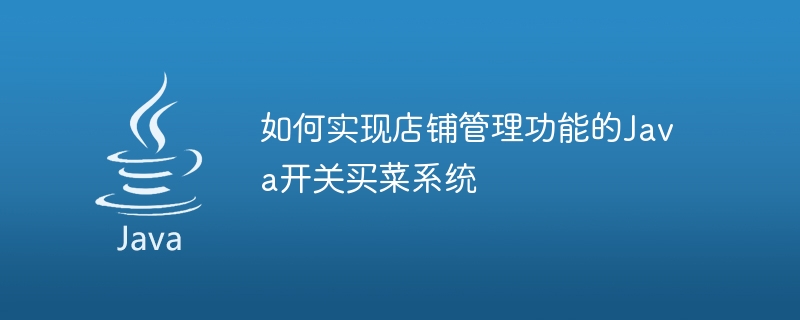Home >Java >javaTutorial >How to implement Java switch grocery shopping system with store management function
How to implement Java switch grocery shopping system with store management function
- WBOYWBOYWBOYWBOYWBOYWBOYWBOYWBOYWBOYWBOYWBOYWBOYWBOriginal
- 2023-11-01 08:57:02950browse

With the improvement of people's living standards, more and more people choose to buy daily ingredients at home. And some emerging e-commerce platforms have also begun to emerge to provide grocery shopping services. In this context, how to implement a convenient and efficient store management function has become an important issue faced by Java developers.
1. Design ideas
- Determine the functions of the system: Store management functions mainly include: product management, order management, member management, inventory management, etc.
- Design system interface: Improve user experience through reasonable interface design.
- Database design: According to the needs of store management functions, design a reasonable database structure to ensure normal storage and access of data.
2. Product management function
- Product classification: Manage products according to categories to facilitate users to quickly find the products they need.
- Product listing and removal: Automatically launch and remove products based on product inventory and sales demand.
- Commodity price management: It is convenient for store managers to adjust the price of commodities according to market demand.
3. Order management function
- Place an order and pay: After the user places an order, the system automatically generates an order and provides a variety of payment methods for the user to choose from.
- Order status management: Update the status of orders in real time to facilitate users and store managers to track order status.
- Order splitting and merging: If the products purchased by the user come from different stores, the system can automatically split and merge the orders to facilitate unified delivery.
4. Member Management Function
- Member registration and login: Users can enjoy more discounts and services by registering as a member and logging in to their account.
- Member level management: Automatically adjust the user's membership level based on the user's consumption and points.
- Member points management: According to the user’s consumption situation, corresponding points are automatically generated to facilitate users’ accumulation and redemption.
5. Inventory management function
- Real-time update of inventory: Automatically update the inventory of goods according to the user's order status and the sales of the goods.
- Inventory warning function: Based on sales data and historical data, predict the sales of goods and adjust inventory in a timely manner.
6. System optimization
- Caching technology: Improve the access speed and performance of the system through reasonable use of caching technology.
- Distributed architecture: By using distributed architecture, the stability and fault tolerance of the system are improved.
7. Security Guarantee
- User data protection: Encrypt and protect users’ private data to eliminate the risk of data leakage.
- Payment security: Use reliable payment platform and encryption technology to ensure the security of the payment process.
- System monitoring and alarming: Quickly discover and resolve potential security issues by monitoring the operating status of the system in real time.
Summary: Through the above design ideas and functional analysis, it is completely feasible to implement a Java switch grocery shopping system with efficient and convenient store management functions. With the powerful functions and advantages of Java development, we can create a fully functional, safe and reliable grocery shopping system to enhance users' shopping experience and promote the healthy development of the e-commerce industry.
The above is the detailed content of How to implement Java switch grocery shopping system with store management function. For more information, please follow other related articles on the PHP Chinese website!
Related articles
See more- JAVA development encounters maven install unresponsive solution
- Detailed explanation of the comparison between C/S and B/S in JAVA development
- vscode builds java development environment
- What are the common middleware in java development?
- How to design a Java switch grocery shopping system with promotional activities function

